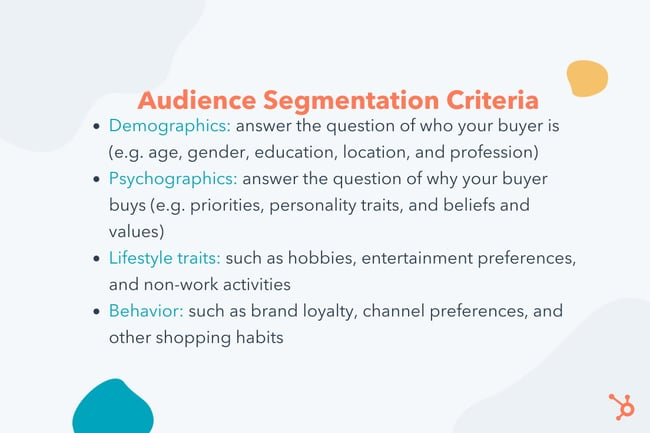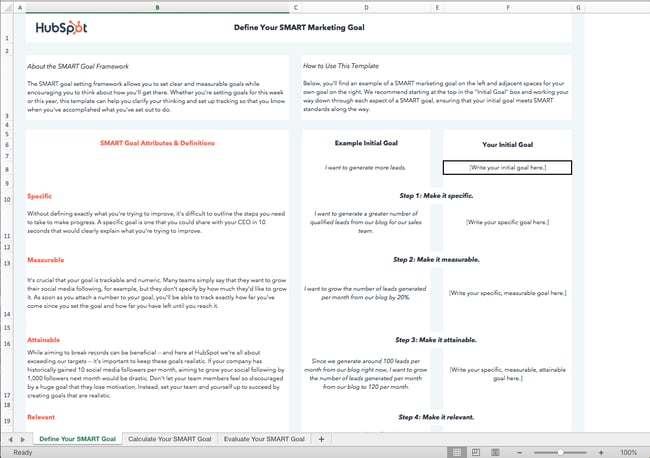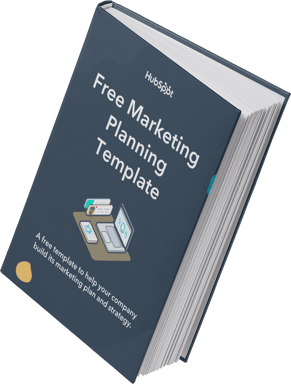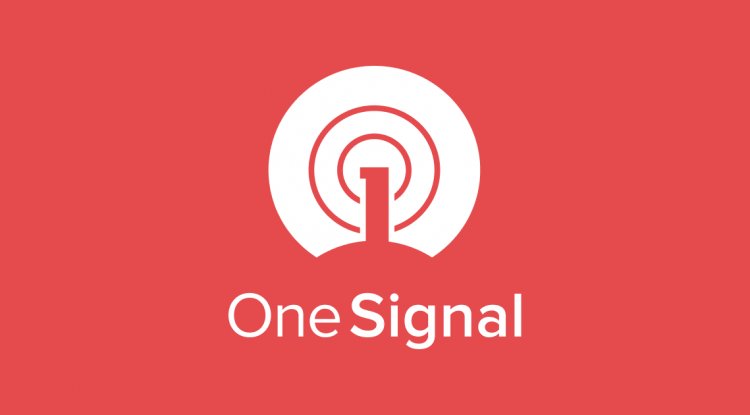7 Steps to Create a Complete Marketing Strategy in 2023
Creating a marketing strategy is essential to effectively nurture your customers, improve the bottom line at your business, and increase the ROI of your efforts.

Creating a marketing strategy is essential to effectively nurture your customers, improve the bottom line at your business, and increase the ROI of your efforts.

A marketing strategy is especially critical if you want to leverage the highest-ROI trends for 2023: short video, influencer marketing, and branded social media. To get powerful results, you must carefully weave both emerging trends and proven strategies into your plan.
Let's dive into the critical components of a complete marketing strategy in 2023, followed by some examples for inspiration.
A marketing strategy will:
- Align your team to specific goals.
- Help you tie your efforts to business objectives.
- Allow you to identify and test what resonates with your target audience.
- Empower you to capitalize on emerging trends.
The last one is especially important for this upcoming year. Keeping up with marketing trends is important for your strategy, but could be a full-time job.
Why? Because in one year alone, we've seen a major shift to short-form video content; the rise and fall of new platforms (looking at you, Meta); and the continuing impact of the global pandemic. In short, what worked for your marketing strategy in the past might not fly today.
To succeed in the fast-paced marketing world — and maintain a sense of relevance with your audience — it's vital to stay ahead of the curve.
To help ease some of that uncertainty, we've going to show you step-by-step how to create a marketing strategy that leaves no stone unturned. But first, let’s go over the individual components that make up a strong marketing strategy.
1. Marketing Mix
The marketing mix, also known as the 4 Ps of marketing, is the preliminary document you must create to understand what you will be marketing, where you’ll be marketing it, and how you’ll be marketing it. The following P’s make up this framework:
- Product: What are you selling?
- Price: What is the price?
- Place: Where will you be selling the product?
- Promotion: Where will you be promoting the product?
You can then extrapolate this information into a full-fledged marketing plan for each promotional channel. It’s important to lay out the information in broad strokes so that you understand the overall direction of your marketing strategy.
2. Marketing Objectives
You can set your marketing objectives in conjunction with your 4 Ps, or right after. Either way, you should outline your marketing goals before building upon your strategy. Why? Because your goals will inform other components of the plan, including the budget and content creation process.
With every objective, you should aim to be as specific as possible. Try to create SMART marketing goals divided by channel or promotional tactic, and don’t forget that you can always come back and revise your goals as your priorities change.
3. Marketing Budget
A marketing budget is an essential element of your strategy. Without allotting funds to hiring the right talent, using the right software, advertising on the right channels, and creating the right content, your marketing strategy won’t have a powerful impact. To get a high return on investment, you must first invest.
Remember that you can always start small — hyper-focusing your budget on one or two efforts — and build upon them once you generate an ROI.
4. Competitive Analysis
Knowing your competition is key when creating a marketing strategy. Otherwise, you risk “yelling into the void” without measurable results. Worse, you won’t know whether you’re differentiating yourself enough from the competition and effectively drawing the attention of your intended audience.
You might already have an idea of whom your competitors are, but it’s still essential to sit down and identify them. You might end up uncovering a surprise competitor who’s vying for your target buyer’s attention and engagement.
5. Segmentation, Targeting, and Positioning

Segmentation, targeting, and positioning (STP) refers to the process of delivering “more relevant, personalized messages to target audiences.” In other words, rather than publishing posts and advertisements on a whim, you’ll go through a methodical process for creating content that resonates with your target buyer.
During the segmentation, targeting, and positioning process, you’ll take three steps:
- Identify your target audience. This process not only entails interviewing your current customers, but carrying out market research and creating buyer personas.
- Target a segment of your target audience. It’s best to speak to a narrow group of highly qualified buyers than to send your message out to everyone.
- Position your brand relative to other brands. What do you do better than your competitors? It’s essential to map this information when creating a marketing strategy.
6. Content Creation

Once you have your budget, competitive outlook, and STP information, it’s now time to take the most critical step: Creating your marketing content. But it’s essential to undertake this effort strategically. For one, you don’t want to publish random content that doesn’t solve for the customer, and for two, you must aim to capitalize on emerging trends so that your brand enjoys high visibility in the marketplace.
The competition is fierce across all formats. According to HubSpot Research, "half of marketers are using videos, with 47% leveraging images, followed by 33% posting blogs articles, infographics (30%) and podcasts or other audio content (28%)." Of these, video has the highest ROI.
 Click here to see a larger version of this image.
Click here to see a larger version of this image.
It’s even more essential to invest in trends that have a high ROI, such as short-form video, influencer marketing, and social media DMs.
That doesn’t mean you shouldn’t invest in blogging, one of the most proven content marketing techniques. It’s simply important to know where to allot the most resources, especially if you have a limited budget.
7. Metrics & Key Performance Indicators (KPIs)

Last, but certainly not least, your marketing strategy must include metrics and key performance indicators to understand how well your strategies are working. The KPIs you choose will vary depending on your business type and preferred customer acquisition channels. Examples of KPIs include:
Now, let’s dive into why it’s important to follow the steps of a marketing strategy.
The Importance of Customer-Driven Marketing Strategy Steps
A robust marketing strategy will reach your target audience — this includes those who have never heard of your brand all the way to repeat customers.
Without a defined strategy, you’ll essentially be throwing things to the wall to see what sticks. And it’s costing you cost, time, and resources.
There are seven key steps to crafting a successful marketing strategy: Build your marketing plan, create your buyer personas, identify your goals, select the tools, review your existing resources, audit and plan media campaigns, and lastly, execute your strategy.
Let’s get into the details of each step in the next section. Or you can jump to the section you're most interested in.
1. Build a marketing plan.
Wait, I have to make a plan for my strategy? What's the difference?
Your marketing strategy provides an overview of the reasons why your marketing team will need certain resources, take certain actions, and set certain goals over the year. Your marketing plan is the specific actions you'll take to achieve that strategy.
Not sure where to start? This free marketing plan template can help.
The right template can help you build a marketing plan that identifies your budget for the year, the initiatives your marketing organization needs to tackle, and the marketing channels you'll use to implement those initiatives.
Plus, it’ll tie everything back to a business summary, to keep you aligned with overarching company goals.
2. Create buyer personas.
If you can't define who your audience is in one sentence, now's your chance to do it. A buyer persona is a snapshot of your ideal customer.
For example, a store like Macy's could define a buyer persona as Budgeting Belinda, a stylish working-class woman in her 30s living in a suburb, looking to fill her closet with designer deals at low prices.
With this description, Macy's Marketing department can picture Budgeting Belinda and work with a clear definition in mind.
Buyer personas have critical demographic and psychographic information, including age, job title, income, location, interests, and challenges. Notice how Belinda has all of those attributes in her description.
You don't have to create your buyer persona with a pen and paper. In fact, HubSpot offers a free template you can use to make your own (and it's really fun).
You can also use a platform like Versium, which helps you identify, understand and reach your target audience through data and artificial intelligence.
Buyer personas should be at the core of building your strategy.
3. Identify your goals.
Your marketing strategy goals should reflect your business goals.
For example, if one of your business goals is to have 300 people attend your annual conference in three months, your goal as a marketer should be along the lines of boosting online registration by 10% at the end of the month to stay on track.
Other marketing goals might be to increase brand awareness or generate high-quality leads. You might also want to grow or maintain thought leadership in your industry or increase customer value.
Whatever your goals, identify what they are and how your marketing organization can work to achieve them over the next year.
4. Select the appropriate tools.
Once you have your goals identified, make sure you have the right tools to measure the success of those goals.
Online software like social media schedulers gives you analytics to help you keep track of what your audience likes and doesn't. Alternatively, you might consider Google Analytics to measure blog and web page performance.
Additionally, make your goals SMART – to do so, take a look at How to Write a SMART Goal [+ Free SMART Goal Template].
Here are a few tools that can help you track and measure the success of your marketing goals:
HubSpot Marketing Hub
The Marketing Hub allows you to consolidate all of your marketing tools into one centralized platform.

Too often, you’ll find a tool that’s powerful but not very easy to use. With this tool, you can attract users with blogs, SEO, and live chat tools. You can then convert and nurture those leads through marketing automation, the landing page builder, and lead tracking features.
With custom reporting and built-in analytics, you can analyze your data and plan out your next move. Plus, HubSpot Marketing Hub integrates with over 500 tools.
Pricing: Free; Starter, $45/month; Professional, $800/month; Enterprise, $3,200/month.
Trello

Trello keeps your marketing team on track and openly communicating about the projects they're working on. Create boards for individual campaigns, editorial calendars, or quarterly goals.
Built-in workflows and automation capabilities keep communication streamlined, and simplicity keeps your marketing team focused on the work that matters.
Pricing: Free; Standard Class, $5/month; Premium Class, $10/month for 100 users; Enterprise, $17.50/month for 250 users.
TrueNorth
 TrueNorth is a marketing management platform built to help you hit your marketing goals. Built specifically for marketing teams, TrueNorth turns your marketing strategy into a visual projection of your growth, which is used to create monthly milestones that help you stay on track.
TrueNorth is a marketing management platform built to help you hit your marketing goals. Built specifically for marketing teams, TrueNorth turns your marketing strategy into a visual projection of your growth, which is used to create monthly milestones that help you stay on track.
One of the key benefits of TrueNorth is that it centralizes all of your ideas, campaigns, and results in one place, with everything tied back to your goal.
Pricing: $115/month (free for 30 days).
Monday.com
 Everything on Monday.com starts with a board or visually driven table. Create and customize workflows for your team and keep groups, items, sub-items, and updates synced in real-time.
Everything on Monday.com starts with a board or visually driven table. Create and customize workflows for your team and keep groups, items, sub-items, and updates synced in real-time.
You can also transform data pulled from timeline and Gantt views to track your projects on Monday.com and ensure deadlines have been met. Plus, with more than 40 integrations — from SurveyMonkey to Mailchimp and, of course, HubSpot — you can visualize your data and ensure your whole company is collaborating.
Pricing: Basic, $8/month/seat; Standard, $10/month/seat; Pro, $16/month/seat; Enterprise, contact for pricing.
SEMrush
 SEO continues to be a huge factor in the successful ranking of your website.
SEO continues to be a huge factor in the successful ranking of your website.
SEMrush allows you to run a technical SEO audit, track daily rankings, analyze your competitor's SEO strategy, research millions of keywords, and even source ideas for earning more organic traffic.
But the benefits don't stop at SEO. Use SEMRush for PPC, building and measuring an effective social media strategy, content planning, and even market research.
Pricing: Pro, $119/month; Guru, $229/month; Business, $449/month.
Buzzsumo

BuzzSumo allows you to analyze data to enhance and lead your marketing strategy, all while exploring high-performing content in your industry.
Use the platform to identify influencers who may help your brand reach, monitor comments, and find trends to make the most of every turn.
As your needs evolve, you can also leverage their crisis management and video marketing tools.
Pricing: Plus, $179/month; Large, $299/month; Enterprise, contact for pricing.
Crazy Egg
 Need to optimize your website this year? Consider getting started with Crazy Egg. You'll be able to identify "attention hotspots" on your product pages, track ad campaign traffic on your site, and understand if shoppers are clicking where you want them to.
Need to optimize your website this year? Consider getting started with Crazy Egg. You'll be able to identify "attention hotspots" on your product pages, track ad campaign traffic on your site, and understand if shoppers are clicking where you want them to.
You can even make sure your "Buy Now" buttons are in the best place.
Crazy Egg also offers recordings, A/B testing, and more to help ensure your website is offering the best user experience.
Pricing: Basic, $24/month; Standard, $49/month; Plus, $99/month; Pro, $249/month; Enterprise, contact for pricing.
5. Review your media.
Decide what you already have in your arsenal that can help you create your strategy. To streamline this process, think of your assets in three categories – paid, owned, and earned media.
- Paid media means any channel you spend money on to attract your target audience. This includes offline channels like television, direct mail, and billboard to online channels like social media, search engines, and websites.
- Owned Media refers to any of the media your marketing team has to create: pictures, videos, podcasts, ebooks, infographics, etc.
- Earned media is another way to say user-generated content. Shares on social media, tweets about your business, and photos posted on Instagram mentioning your brand are all examples of earned media.
Gather your materials in each media type and consolidate them in one location to have a clear vision of what you have and how you can integrate them to maximize your strategy.
For example, if you already have a blog that's rolling out weekly content in your niche (owned media), you might consider promoting your blog posts on Twitter (paid media), which customers might then reTweet (earned media). Ultimately, that will help you create a better, more well-rounded marketing strategy.
If you have resources that don't fit into your goals, nix them. This is a great time to clean house and identify gaps in your materials.
6. Audit and plan media campaigns.
Cleaning house segues straight into this step. Now, you must decide which content is going to help you.
Focus on your owned media and marketing goals. For instance, will updating the CTAs at the end of your blog posts help you increase RSVPs to your event?
Next, look at your buyer personas. Let's say you work for a video editing software company. If one of your persona's challenges is adding clean sound effects to their videos but you don't have any content that reflects that, make a 15-second demo video for Instagram to show how great your product is at solving that challenge.
Finally, create a content creation plan. The plan should include topic clusters, goals, format, and channel for each piece of content. Be sure to include which challenge it's solving for your buyer persona.
For ideas on content creation or a more in-depth look at how to create a content plan, check out our post, The Ultimate Guide to Content Creation.
7. Bring it to fruition.
At this point, your market research and planning should help you visualize how your strategy will be executed – and by which teams.
The final step is to bring that all together and assign actions to your plans.
Create a document that maps out the steps you need to take to execute your campaign. In other words, define your strategy.
Think long-term when creating this document. A standard strategy document is 12 months. This structured timeline should be the home base for your strategic marketing efforts.
To paint an example, let's go back to the video software company.
Maybe in January, you will launch a software update that improves the exportation process for users. In April, you want to publish an ebook that explains editing terms to your buyer personas, and in September, you plan to launch an integration with other software.
Remember, your digital strategy is unique to your business, so the document should be as well. As long as the strategy includes the pertinent details outlined in previous sections, you'll be set.
Now that we've explored the critical steps of a complete marketing strategy, let's look at some "Why didn't I think of that?" strategies to inspire your own.
Examples of Successful Marketing Strategies
1. Regal Movies
Digital strategy: Owned media
Regal Movies took the Halloween spirit to a new level, even renaming its Twitter account to reflect the spirit of the season. This "Monster Madness" poll is a fun, interactive way to get followers invested in Regal's content:

Regal's tweet is an example of owned media because the company was in full control of the answers followers gave (and, apparently, American Werewolf didn't stand a chance).
Regal effectively kept true to their brand by using only classic movies in their poll while still putting a modern spin on it.
This is also a good example of how retweets don't necessarily equal success. While four retweets aren't that big of a deal, check out the votes: 461. That means there were over 400 interactions with a single tweet.
2. La Croix
Digital strategy: User-generated content, earned media
User-generated content is one of the best ways to gain traction in your strategy.
It demonstrates your appreciation for loyal customers, builds community, and also incentivizes other users' to promote your products for the chance at a similar shout-out.
Plus, sometimes the content your brand loyalists create is really, really good.

In this case, the consumer is praising the brand’s product. Doesn’t get better than a fantastic review like that.
3. Small Girls PR
Digital strategy: Event marketing
Wait, is that Keke Palmer?

Small Girls PR is a boutique PR company based in New York, and one of the company's talents is throwing amazing events for their clients, like Olay. This event recap carousel on Instagram is an effective event marketing example, as it boosts awareness for your brand and offers social proof by featuring a public figure.
4. Superside
Digital strategy: Paid media
Design agency Superside launched an Instagram ad to promote a lead magnet: Their digital ad design guide. While the brand may have created the guide specifically for paid promotions, it’s also possible that they repurposed a high-performing blog post into a downloadable ebook.

In this case, all they had to do was repackage their current content, build an ad around it with creative assets, and run it.
In previous sections, we discussed the power of leveraging multiple forms of media in your marketing strategy. This is a great example of it.
5. Target
Digital strategy: Paid media, Twitter cards
If you've got the budget for paid media, take full advantage of it.
Paid media is when you pay social channels, like Twitter, to promote your content on their site. By doing this, your content reaches new audiences you might not be able to reach organically:

This inclusive ad from Target about fall shopping uses Twitter cards to promote the brand and make shopping easy with the click of a button.
More social channels are offering ways for shoppers to purchase in-app or close to it, driving sales and boosting exposure for brands.
What to Expect After Following Your Marketing Process Steps
Ultimately, creating a complete marketing strategy isn't something that can happen overnight. It takes time, hard work, and dedication to ensure you're reaching your ideal audience, whenever and wherever they want to be reached.
Stick with it (and use some of the resources we've included in this post), and over time, research and customer feedback will help you refine your strategy to ensure you're spending most of your time on the marketing channels your audience cares most about.
Editor's note: This post was originally published in October 2019. It has been updated for freshness and accuracy.
What's Your Reaction?



























